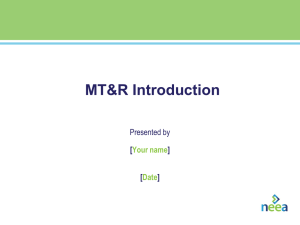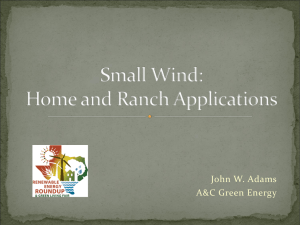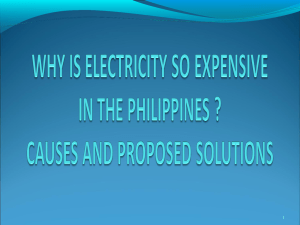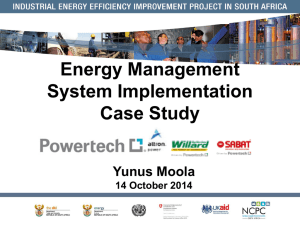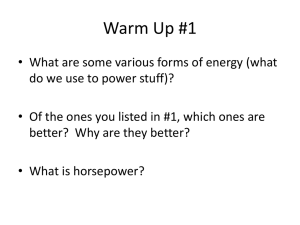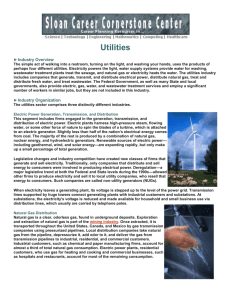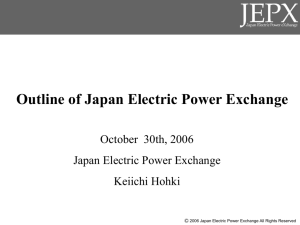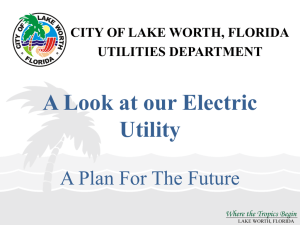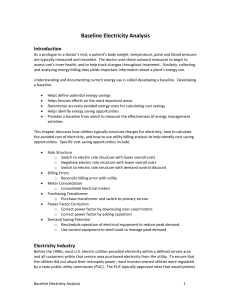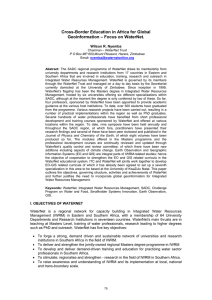Energy use in water utilities-BoNJ-EEA v 2.1 - Eionet Projects
advertisement
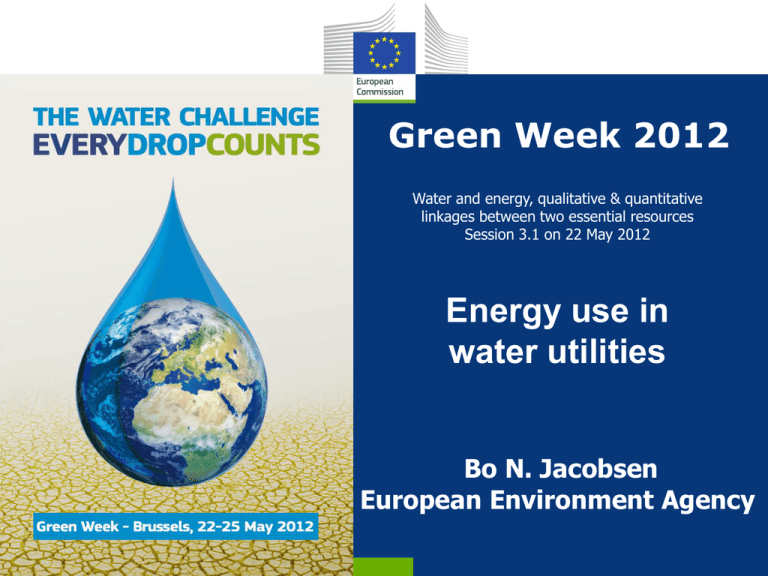
Green Week 2012 Water and energy, qualitative & quantitative linkages between two essential resources Session 3.1 on 22 May 2012 Energy use in water utilities Bo N. Jacobsen European Environment Agency Several links in the water – energy nexus Image: ActewAGL Education Website Focus: Energy efficiency (intensity) in water utilities 2 Resource efficiency – policy - targets New EEA report – launch at WWF6 EU resource–efficiency policy - Resource efficiency - Sustainable water management Water-resource efficiency - Water use efficiency - Energy use in water utilities - Nutrient recovery 3 Using markets - Economic instruments - Water pricing & cost recovery Improved info on management - Indicators - Water accounting - Water footprint and LCA - Labelling, certification, standards,.. Resource efficiency – policy - targets Resource and impact decoupling - Resource decoupling can be achieved by improved water/energy efficiency per GDP or population - is relative - Impact decoupling requires reduction in water/energy use – is absolute Source: UNEP, 2011 Resource efficiency – policy - targets Energy efficiency in water utilities • Currently no specific European regulations on energy efficiency in water utilities • EC Communications ”Roadmap to a Resource Efficient Europe” - specifies milestones and activities for COM and Member States describes general directions, including water and energy efficiency link ”European Innovation Partnership on Water” - • - Establish a stakeholder platform and web-based Market Place for water innovations in 2013 ..”Innovative solutions focussing on the relationship between water and energy, water efficiency (domestic and industrial), water quality, water infrastructure, recreation, public health and ICT-enabled user awareness will be of key importance.”.. Opportunity for water utilities / associations, pro-actively, to formulate targets and corresponding commitments Link Resource efficiency – policy - targets Global trends and policies on climate and emissions/energy • Global Targets: 2 degree celsius • Regional targets: EU 20-20-20 by year 2020 • A reduction in EU greenhouse gas emissions of at least 20% below 1990 levels • 20% of EU energy consumption to come from renewable resources • A 20% reduction in primary energy use compared with projected levels, to be achieved by improving energy efficiency • National Targets: e.g., Netherlands: 30-30-30 • Utility targets? • WWF6 targets: 20% improvement in energy efficiency (1990 level - 2020) Energy intensity in the urban water cycle The urban water cycle – energy nexus Waste Water Waste water treatment Transport to waterworks 0.24 kWh/m3 Drinking Water Drinking water treatment 0.9 - 10 kWh/m3 0.13 kWh/m3 Transport sewage water Drinking water Distribution 0.11 kWh/m3 0.16 kWh/m3 Domestic Water use > 50 kWh/m3 Data from Sweden Based on: (Olsson, 2012 in press) Energy intensity in the urban water cycle Example of energy efficiency indicator: Odyssee energy efficiency index (ODEX) (EU-27) Water heating in households 20% improvement in efficiency ! 8 Source: (EEA, Ener22) Energy intensity in the urban water cycle Systematic analyses for UWWTP energy efficiency in North Rhine-Westphalia, Germany 10-year experiences •Energy consumption in 645 UWWTPs 1200 mio kWhe/y •35 mio p.e. Served; 18 mio inhabitants – 34 kWh/p.e.(load)/y or – 67 kWh/p/y *) •Support with up to 70% of cost for energy analysis •Since 2012 also support to measures •Financed from effluent taxation revenue •Experience: about 30% energy saving possible most commonly by: – – – electricity and heat production from the digester gas, utilizing the heat energy contained in the sewage in some cases by the use of hydropower from the slope of the wastewater plants http://www.umwelt.nrw.de/umwelt/pdf/karte_komm_klaeranlagen.pdf *) calculated by this author Energy intensity in the urban water cycle The influence of UWWTP size Total electricity consumption in about 10,000 UWWTPs in Germany is 4400 GWh/y http://www.bmu.de/files/english/pdf/application/pdf/faltblatt_wasserwirtschaft_en_bf.pdf Corresponds well with mean of 33 kWh/p.e. (European benchmarking Co-operation, 2010) 10 Energy intensity in the urban water cycle Total end-use electricity consumption per capita in 2008 (kWh/y/person) In perspective: - Total consumption ca. 5500 kWhe/y/p - From earlier slide for urban wastewater treatment: 67 kWhe/y/p In other words - 11 ca. 1.2 % of total electricity consumption Ca. 7 W/p (small light bulb continously burning) Net consumption lower where energy recovery takes place Source: (ENER18) Energy intensity in the urban water cycle Inventory from UK indicate GHG emission related to water: - Utilities: 0.8 % - In homes: 5.5 % (Defra, 2008; EA, 2008) (Defra, 2008; EA, 2008) Average ca. 10 t CO2-eq./y/p Source: (EEA,2011) 12 link Energy intensity in the urban water cycle Thermal energy from groundwater Cooling from surface water Waternet, Amsterdam (The Netherlands): Urban Water Cycle – Energy efficiency and recovery • Consumption > drinking water 45.000 MWh/yr (49 %) > wastewater 39.000 MWh/yr (42 %) > watersystem 8.000 MWh/yr ( 9 %) Co-locating: Waste Water – Solid Waste Incinerator • Production biogas/sludge 25.000 MWh/yr Source: Waternet 2011 Waste Water Plant Sludge and Biogas Heat and Electricity Waste Inceneration Plant Dissemination Numerous technological solutions exist - communicated via water associations - incentives for further implementation needed Link Some IWA events on Water & Energy - 2008: Workshop during World Water Congress, Vienna - 2009: Int. Conference on W & E, Copenhagen - 2010: Int. Conference on W & E, Amsterdam - 2012: World Congress on W, C & E, Dublin New books on Water & Energy -- Interactions in Water Reuse (Lazarova, Choo, and Cornel, 2012) - Threats and Opportunities Link (Olsson, 2012 in press) Numerous Tech.sci. Papers - Instrumentation, control, automation, process optimisation,.. - Anaerobic treatment processes, co-digestion,.. - Heat exchange, .... Link Looking forward Some open questions for establishing water utility energy efficiency indicator(s): Willingness to share data from water utilities … from plants, city administrations, associations ? Level of aggregation … national, river basin district, per plant? Boundary framing Total energy balance /only electricity ? Total UWWTP (incl./excl. Incinerations, industrial pre-treatment, storm water,.. Normalisation Per person, per p.e., per m3 15 Looking forward Existing data infrastructure in EU 27 can be used: WISE has database and interactive maps for > 20,000 UWWTPs 16 Link Looking forward Summary and way forward Water and energy sectors can have several synergies in the climate change context Power consumption by European water utilities is ”only” few % of use in society but has reduction potentials • Like the rest of society, utilities need to reduce carbon footprints • Population growth and higher quality standards makes this more difficult • • Technological solutions do exist - several good use case demonstrations wastewater sector has a potential to become CO2-neutral • Fiscal incentives may accelerate implementation of sustainable technologies Targets for water utilities should be set for energy efficiency • WWF6 targets: 20% improved energy efficiency (1990-2020) – not enough for EU 20/20/20 targets (absolute reduction) • Indicators are needed to provide status and to monitor progress • Existing data infrastructures (WISE, Eye-on-Earth,..) may be helpful Multi-stakeholder involvement needed 17 • Political level: policies, targets, support mechanisms • Technical operating level: new technology implementation & optimisation • User level: awareness and demand management Thank you for your attention! Contact e-mail: bo.jacobsen@eea.europa.eu 18

